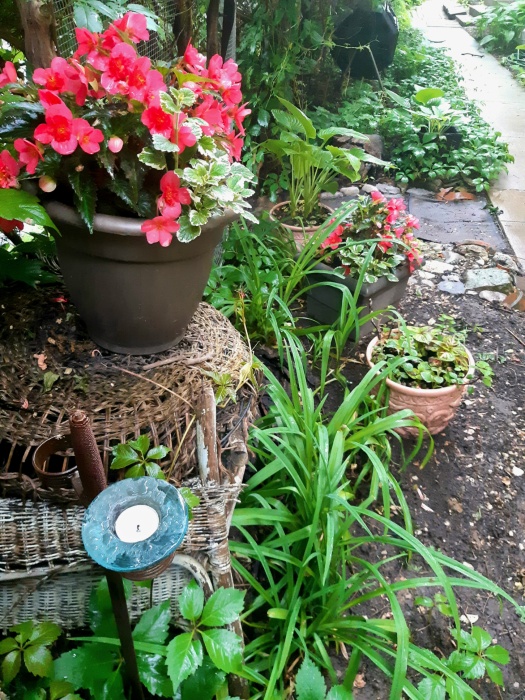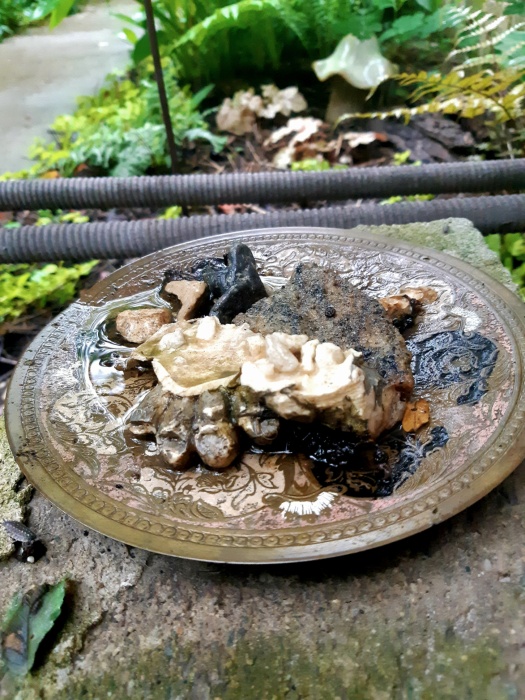
A garden has a lot to teach, of patience, compromise, of light and shadow and how to play with it, of creation, of beginnings and endings. You learn from a garden that indeed the eye does like to travel, as someone once said, in sweeps of singularity of colour or type, drawing you forward to the heart of it, or framing the prize view.
Gardens offer gifts and surprises, but you must be open to see them for what they are, and learn to go with the flow of the garden. The garden knows what it wants, what it needs, if one listens, watches it, feels it, as a precious summer breeze.

Gardens have limits, boundaries and borders that you learn to work within, to respect them, contrive to help them thrive.
One also learns along the way that if you build it they will come, sometimes, and at unexpected times, seemingly from nowhere.
For everything there is a season, and
Ecclesiastes, chapter 3, verses 1-8
a time for every matter under heaven
a time to be born, and a time to die
a time to plant, and a time to pluck up what is planted;
a time to kill, and a time to heal;
a time to break down, and a time to build up;
So, day after day, month by month, year upon year, you nurture that earth, adding humus, and not being too neat and tidy, as a woodland thrives when left to its own devices – well, I guess we all can. You learn how letting the twigs and leaves just rot away as they please, being feed and fodder to the worms, and all the insects that makes their home amongst that detritus, has a place, a job, a purpose.
You also learn to remind yourself to eat more fresh greens, and not just for your own well-being, but for the compost and eventually, over time, for the well-being of the garden.
So this year that barrel roll style composter D3 gave me, even though it is in a mostly shady spot, came ripe this spring, and so it was added to the garden… sprinkled around liberally, especially for those antique Ostrich Ferns that love there …poo…er ‘humus’.

I also learned that if those delicate ferns were planted near the Hosta’s, that their leaves will offer shade and a bit of a respite on those hot summer days, to rest their delicate fronds upon.
A garden teaches you to love the rain, and you find yourself mesmerized, fascinated and enchanted with how everything shines and lifts itself up, eyes closed (or so I imagine), soaking it all in… Ooommmm.

Though, it also makes one wish for covered screen porches, but anywho.
a time to weep, and a time to laugh;
IBID
a time to mourn, and a time to dance;
a time to throw away stones, and a
time to gather stones together;
a time to embrace, and a time to
refrain from embracing;
a time to seek, and a time to lose;
Instead, I sit at my door, on a milk crate and pillow, and watch the rain fall, only venturing out to let the rain wash away any negativity, any bad hoogie moogie, any nasty mojo that may have attached itself, or, so I imagine – and it works every time.
Maybe that is another thing a garden teaches, is how to look at things differently, to adjust the focus, gain perspective, think long term, to feel, touch, experience the now, the here.
A garden emphasizes, maybe strengthens too, the idea that you may not get what you want, but oh, it will always give you what you need (even if you didn’t know you did).
Amen, hallelujah, namaste, and holy and sacred be a garden.
And to have patience, and faith, to let whatever will be just be, everything in its own time.
a time to keep, and a time to throw away;
IBID
a time to tear, and a time to sew;
a time to keep silence, and a time to speak;
a time to love, and a time to hate;
a time for war, and a time for peace.
Yes, for everything there is a season.
So of surprises and gifts, this Lungwort just showed up out of nowhere the second spring, in 2014, when everything was new and I didn’t yet know what this garden needed, wanted, but there it was, hiding in the shadows.
I had been puttering, looking around to see what had shown up, what had decided to make this garden its home, because if you build it they will come. Well, so there I saw this spotted thing hiding over beside the hedge, in the shadows – I knew those spotted leaves, knew exactly what it was, and it brought a smile.
So this spring, in the merry month of May, that Lungwort finally flowered. Finally, I say, because for the past 4 or so years since it arrived it just did nothing but spread out a bit, just languished underneath the hosta, in the shade, just as it likes, stubbornly not flowering.
I love this plant, and its merry spotted leaves and flowers that turn from purple to pink. I used to have one in my garden long, long ago, in the 90s, back in the dark ages when I was married. Left that garden, walked away, and that was one of the things I still missed, that lovely Mrs. Moon Lungwort that mom gave me.
Lungworts are not particularly fussy, but they do have some preferences, and one of those things they require is to be shaded from the harsh summer sun, which back in those dark ages I had little of (maybe a message in that).
They prefer to languish the summer away underneath something, in this case a big Plantaginea hosta leaf. In the shade they add a wee bit of speckledness, and ramble along the concrete sidewalk, peeking out from underneath, sometimes spreading more of those little gifts around the garden, if you please, I wouldn’t mind at all.


USES: People take lungwort to treat breathing conditions, stomach and intestinal ailments, and kidney and urinary tract problems. Lungwort is also used in cough medicines, to relieve fluid retention, and to treat lung diseases such as tuberculosis. [ WEBMD ]
↫ |
↬ |
|---|
3 thoughts on “Some Tales From A Rented Garden, Of Time, Lessons, and That Lungwort Flowers”